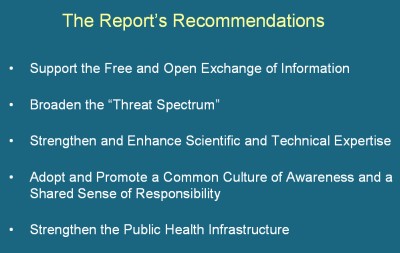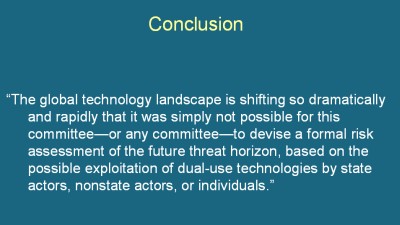Cryonic Enabling Technology and the Bioweapons Risk
Douglas Mulhall
Page 2 of 3
The main recommendations were to: 1) Support the free and open exchange of information in the scientific community and elsewhere; 2) broaden the threat spectrum; 3) strengthen and enhance scientific and technical expertise; 4) adopt and promote a common culture of awareness and a shared sense of responsibility (that is sort of a nice, all encompassing moralistic approach); and 5) strengthen the public health infrastructure.
In supporting the free and open exchange of information, there is one point that signifies a great paradox. For example, an editorial was published in the New York Times by a prominent scientist saying that the genome of certain viruses, engineered viruses, should not be published because of the terrorist threat.
The committee basically said "nonsense" to such calls not to publish these things, because they basically concluded the genie is already out of the bottle in academic circles. Committee members also point out that to demonstrate proof of concept you have to publish these things anyway.
The committee has been quite adamant that trying to suppress or restrict publication of these dual-use applications simply will not work. I think that is a very important thing for us all to be cognizant of.
The committee wants free and open exchange of information throughout all of these research projects. However, any secret weapons research going on in two or three dozen countries around the world is diametrically opposed to that philosophy.

“Broaden the threat spectrum.” What the committee is saying here is that the military -- and this applies to the United States but you could apply it to every country on Earth -- biodefense programs, basically do not have a broad enough concept of what the potential for nanotech is, so the definition should be broadened.
The committee concluded the national security community has to build better analytical capability to deal with these types of threats. Well, of course, the problem there is, if you look at Vietnam, Iran, the collapse of the Soviet Union, Iraq and 9/11, none of which the intelligence community was able to either detect or to warn the government properly about, you can see the difficulties associated with this, especially looking at the rapidity with which nanotechnology research develops.
“Common culture of awareness and a shared sense of responsibility.” This is something, of course, that Einstein and many scientists before him had said, so it is nothing new: we are all in this together. A footnote by the committee notes that anyone with a sense of morality should report nasty activities to national authorities. The problem here is they are asking you to be a whistle blower. Whistle blowing has not worked that well in either the military research community or the corporate community. Whistle blowers in fact, despite all alleged protections for them, do not do very well. There is a lot of pressure not to blow the whistle. In fact, institutionally the military makes a practice of ostracizing whistle blowers, to say the least. The military is where a lot of the research is going on.
Next recommendation: “Strengthen the public health infrastructure.” There have been calls for many, many years to strengthen the infrastructure, for example, when we saw the SARS [10] epidemic happen in Canada and Asia, which gave a very nice example of how unprepared we are.
The committee pointed out that since September 11, 2001 very little has happened in this area. Hurricane Katrina and the 2008 Midwest flooding were indicative that we have not really moved very far.
Here is probably the most profound part of that report; the need for us to develop parameters and to develop predictability so the technology can move ahead. But the committee basically concluded this is not possible. To quote:
"The global technology landscape is shifting so dramatically and rapidly that it was simply not possible for this committee, or any committee, to devise a formal risk assessment of the future threat horizon based on the possible exploitation of dual use technologies by state actors, non state actors, or individuals."
Now this takes us back to Vernor Vinge [11], who predicted in the early 1990s that within thirty-five years, a superhuman intelligence would emerge, and shortly thereafter, the human era would end. He also pointed out that meant predicting anything would become virtually impossible. This event is often referred to as “The Singularity.”

Well, it appears as though the symptoms of the Singularity [12] are upon us already with the aforementioned conclusion by some of the leading scientists in the United States. The committee is telling us it is impossible to predict anything. It is impossible to develop predictability. Therefore, I will just put an exclamation point there, because that is the main point of this article.
After that, the committee disbanded and passed on the responsibility for this to groups such as the National Science Advisory Board for Biosecurity. [13] You can go on their website and have a look at what they are talking about.
Footnotes
[10] Severe Acute Respiratory Syndrome (SARS) - a viral respiratory illness caused by a coronavirus, called SARS-associated coronavirus (SARS-CoV). SARS was first reported in Asia in February 2003. Over the next few months, the illness spread to more than two dozen countries in North America, South America, Europe, and Asia before the SARS global outbreak of 2003 was contained.
http://www.cdc.gov/ncidod/sars/factsheet.htm September 26, 2008 11:39AM EST
[11] Vernor Steffen Vinge - a mathematician, computer scientist and science fiction author who is best known for his Hugo award-winning novel A Fire Upon the Deep, and for his 1993 essay "The Technological Singularity", in which he argues that exponential growth in technology will reach a point beyond which we cannot even speculate about the consequences.
http://www.biblio.com/authors/200/Vernor_Vinge_Biography.html October 1, 2008 11:49AM EST
[12] Singularity - The technological singularity is a theoretical future point of unprecedented technological progress, caused in part by the ability of machines or humans to improve themselves using artificial intelligence.
http://www.singinst.org/overview/whatisthesingularity Oct. 1, 2008 8:30 AM EST
[13] National Science Advisory Board for Biosecurity (NSABB) - established to provide advice to federal departments and agencies on ways to minimize the possibility that knowledge and technologies emanating from vitally important biological research will be misused to threaten public health or national security. The NSABB is a critical component of a set of federal initiatives to promote biosecurity in life science research.
http://www.biosecurityboard.gov/ September 26, 2008 11:50AM EST